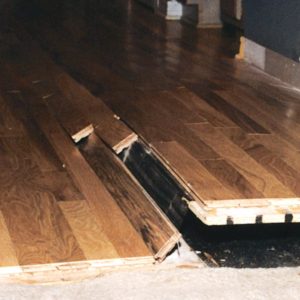Maintenance and climate control are two key factors in the long term success of a wood floor. To fully understand how the current environment effects a wood floor, let’s start from the beginning. In the live tree, the fibers are loaded with moisture as sap. When looking at the growth ring of a tree you can visually see when there was a draught during its lifespan. After being cut the tree begins to dry out, just like a flower will wilt after it's picked.
The careful drying of lumber is imperative when manufacturing wood flooring. To successfully dry lumber, a full understanding of moisture and wood is required. Drying time can vary significantly depending upon wood species, initial moisture level, lumber thickness, density, ambient conditions and processing techniques.
Kiln drying is frequently used to control the drying process. While there are various types of kilns used to dry lumber, the basic premise is to balance and control humidity, temperature and airflow. This safely and efficiently brings wood down to an acceptable moisture content.
The manufacturing of wood flooring cannot entirely prevent an unsuccessful installation. Installers benefit with an understanding of moisture's effect on wood in some detail and can then educate the end-user on maintaining the floor.
Some manufacturers have climate controlled environments and maintain the moisture levels throughout the manufacturing process, thus controlling the moisture content of the wood up until the point it is placed on the truck for delivery. Various parts of the country range, from the dry desert areas of the Southwest to the moist areas along the Gulf of Mexico. That’s why it’s critical that flooring remain in a climate controlled environment, and not introduced to a new job site until the environment is climate controlled and within recommended ranges. Many manufacturers record moisture-meter readings when the raw lumber is delivered to the plant and before the flooring leaves the facilities. Such readings would be attached to the invoice or packing lists.
According to the National Wood Flooring Association: “Wood flooring will perform best when the interior environment is controlled to stay within a relative humidity range of 30 to 50 percent and a temperature range 60 to 80 degrees Fahrenheit. Fortunately, that's about the same comfort range most humans enjoy.” The actual moisture content equilibrium of wood flooring is in the 6 to 9 percent range; this is within the range that most hardwood flooring is manufactured. Although some movement can be expected even between 6 and 9 percent, wood can expand and shrink dramatically outside that range.
Generally speaking, solid wood flooring will contract during periods of low humidity (usually during the heating season), sometimes leaving noticeable cracks between boards, cupboards and doors. That’s when you need to run a humidification system to add moisture back into the air. When humidity increases too much, the effect on wood flooring can be damaging — causing cupping and buckling and a de-humidifier is necessary.
As you can see, wood flooring does require some knowledge and maintenance. However, one of the major advantages of a wood floor is, if properly cared for, it will last a lifetime.




